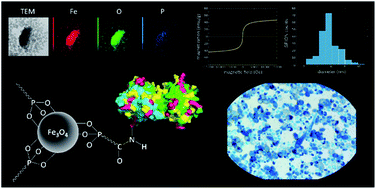OBP-functionalized/hybrid superparamagnetic nanoparticles for Candida albicans treatment†
Abstract
Infections caused by the opportunistic yeast Candida albicans are one of the major life threats for hospitalized and immunocompromised patients, as a result of antibiotic and long-term antifungal treatment abuse. Odorant binding proteins can be considered interesting candidates to develop systems able to reduce the proliferation and virulence of this yeast, because of their intrinsic antimicrobial properties and complexation capabilities toward farnesol, the major quorum sensing molecule of Candida albicans. In the present study, a hybrid system characterized by a superparamagnetic iron oxide core functionalized with bovine odorant binding protein (bOBP) was successfully developed. The nanoparticles were designed to be suitable for magnetic protein delivery to inflamed areas of the body. The inorganic superparamagnetic core was characterized by an average diameter of 6.5 ± 1.1 nm and a spherical shape. Nanoparticles were functionalized by using 11-phosphonoundecanoic acid as spacer and linked to bOBP via amide bonds, resulting in a concentration level of 26.0 ± 1.2 mg bOBP/g SPIONs. Finally, both the biocompatibility of the developed hybrid system and the fungistatic activity against Candida albicans by submicromolar OBP levels were demonstrated by in vitro experiments.

- This article is part of the themed collection: 2021 RSC Advances HOT Article Collection


 Please wait while we load your content...
Please wait while we load your content...